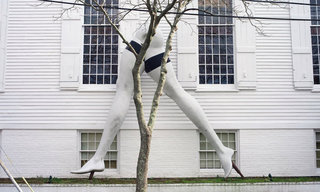Art Has Legs - New York Times Op-Ed

The New York Times
By BARBARA GOLDSMITH
Published: March 25, 2012
IT may seem an insignificant power spat in the small village of Sag Harbor, on Long Island. It isn’t. It is a quintessential example of a continuing, centuries-old battle over what can be deemed art, what can’t and who can rightfully judge the difference. I should say who among the living, for time has a way of sorting it all out.
For about four years, close to the side of their white clapboard home, the gallery owners Ruth Vered and Janet Lehr displayed a Larry Rivers mixed-media construction of a pair of attenuated fiberglass legs, 16 feet tall, modeled on a 1969 work called “40 Feet of Fashion.” Rivers, the provocative painter, sculptor and filmmaker, died in 2002. By 2010, a Rivers painting had sold for $1,142,500; that year, Fred W. Thiele Jr., the Sag Harbor village attorney and a state assemblyman, decided that Rivers’ “Legs” — which had long been established and exhibited as a work of art — was, in fact, a “structure.” As such, it was not a “conforming use,” according to the village code. (Mr. Thiele dug in his heels and told a Times reporter, “It’s a structure, and a structure is a structure is a structure.”)
Gayle Pickering, chairwoman of the Zoning Board of Appeals, tried to deflect the issue by saying: “This is not a decision about art. It’s about setting a precedent for building structures.” Try to get your head around that bit of specious reasoning.
Last month there was a public meeting to decide for or against removal. By this time, the board had received so many e-mails, letters and faxes from museum experts, art critics and members of the general public advocating that the Rivers sculpture was a proven work of art and not a so-called structure and should remain in place, that another meeting was scheduled for last Tuesday, when the board voted not to vote on the issue but to postpone a decision until April 17. The board also decreed an end to all public input.
Flashback: Often the judgment of what is and is not art, as in the case of Rivers’ “Legs,” becomes bogged down in a legal process. In 1926 when Edward Steichen, the noted photographer, tried to bring Constantin Brancusi’s bronze abstract “Bird in Space” through United States Customs, it was relegated to the category of “Kitchen Utensils and Hospital Supplies.” Steichen was forced to pay a $240 duty.
Gertrude Vanderbilt Whitney subsidized a lawsuit Mr. Steichen filed appealing the decision. After a 13-month trial, a forward-looking judge declared that the piece was an “original production of a professional sculptor” and “a work of art.” He concluded, “We sustain the protest and find that it is entitled to free entry.” Brancusi ended up making several versions of “Bird in Space,” and one sold in 2005 for $27,456,000. Time has caught up with aesthetics.
Throughout history, self-styled arbiters have taken it upon themselves to decide the question of what can or cannot be the legitimate purview of art. In 1966, the Stephen Radich Gallery displayed a Marc Morrel sculpture protesting the Vietnam War of an American flag wrapped around a drooping phallus. Mr. Radich was charged with violating a law that stated, “No person shall publicly mutilate, deface, defile or defy, trample upon or cast contempt upon” the American flag. A seven-year legal battle followed. In his testimony, Mr. Radich gave other examples of protest art including Goya’s “Disasters of War” and Picasso’s “Guernica.” The prosecutor, however, declared that Mr. Morrel’s work was, in fact, a non-art object. A 60-day jail sentence or maximum fine of $500 was imposed.
And here’s one for absurdity: In 1959, Robert Rauschenberg created an assemblage, “Canyon” which featured a taxidermy-treated bald eagle. The work belonged to the estate of the art dealer Ileana Sonnabend, where it was valued at zero dollars because, under a federal law that prohibits the possession of bald eagles (dead or alive), the work can never be sold. Nevertheless, the I.R.S. valued “Canyon” at $65 million and taxed it at that price. (Ms. Sonnabend’s estate had already paid more than $450 million in taxes connected to the sales of some of her other art.) A Catch-22 if ever there was one.
I am guilty of using dollar signs as proof of a work of art’s longevity. In January, the financial advisory firm Alternative Asset Analysis declared art a better investment than equities. Is this a proper criterion leading to judgment? Absolutely not.
What is? That’s a question that perhaps our great-grandchildren may be able to answer. Even then, they may answer it only for their own time. Today’s controversial art might be tomorrow’s masterpiece, the once reviled now revered. The Sag Harbor board that decides whether to let Larry Rivers’ “Legs” stand in place would be wise to remember what Hippocrates wrote around 400 B.C.:
Life is short,
Art long,
Opportunity fleeting,
Experience treacherous,
Judgment difficult.
A former art writer for The New York Herald Tribune and New York magazine and the author of books including “Obsessive Genius: The Inner World of Marie Curie.”